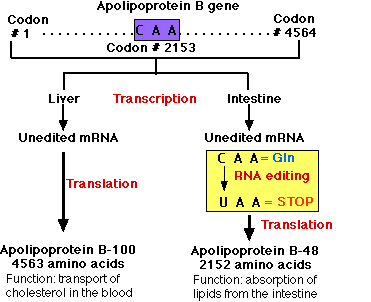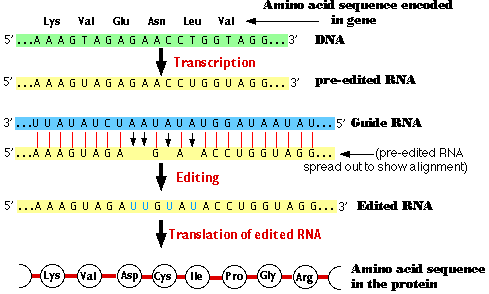Occasionally researches encounter a gene with a sequence of nucleotides that does not match exactly that in its RNA product:
- messenger RNA (mRNA) or
- ribosomal RNA (rRNA) or
- transfer RNA (tRNA)
If the product is mRNA, some of the codons in the open reading frame (ORF) of the gene specify different amino acids from those in the protein translated from the mRNA of the gene.
The reason is RNA editing: the alteration of the sequence of nucleotides in the RNA
RNA editing occurs by two distinct mechanisms:
Humans have a single locus encoding the APOB gene.

- It contains 29 exons (separated by 28 introns).
- The exons contain a total of 4564 codons.
- Codon 2153 is CAA, which is a codon for the amino acid glutamine (Gln).
- The gene is expressed in cells of both the liver and the intestine.
- In both locations, transcription produces a pre-messenger RNA that must be spliced to produce the mRNA to be translated into protein.
- In the Liver. Here the process occurs normally producing apolipoprotein B-100 — a protein containing 4,563 amino acids — that is essential for the transport of cholesterol and other lipids in the blood.
- In the Intestine.
- In the cells of the intestine, an additional step of pre-mRNA processing occurs: the chemical modification of the C nucleotide in Codon 2153 (CAA) into a U.
- This RNA editing changes the codon from one encoding the amino acid glutamine (Gln) to a STOP codon (UAA)
- The modification is catalyzed by the enzyme cytidine deaminase that
- recognizes the sequence of the RNA at that one place in the molecule and
- catalyzes the deamination of C thus forming U.
- Translation of the mRNA stops at codon #2153 forming apolipoprotein B-48 — a protein containing 2152 amino acids — that aids in the absorption of dietary lipids from the contents of the intestine.
| B cells express another cytidine deaminase (called activation-induced cytidine deaminase or AID) that is essential for both class switch recombination (CSR) and somatic hypermutation (SHM) of antibody genes. Humans with disabling mutations in the gene for this enzyme produce only IgM antibodies. However, here the enzyme is acting on DNA, not RNA. In attempting to repair the mismatch formed (dC•dG converted to dU•dG), the normal DNA repair machinery of the cell produces CSR or SHM as the situation warrants. |
- Some mRNAs, tRNAs, and rRNAs in both the mitochondria and chloroplasts of plants
- mRNAs encoding subunits of some receptors of neurotransmitters in the mammalian brain, e.g.,
- a tRNA in the mitochondria of the duckbill platypus
Example: the gene (in the mitochondria of Trypanosoma brucei) for one of the subunits of cytochrome c oxidase
Several genes encoded in the mitochondrial DNA of this species (the cause of sleeping sickness in humans) encode transcripts that must be edited to make the mRNA molecules that will be translated into protein.
Editing requires a special class of RNA molecules called guide RNA (gRNA).

These small molecules have sequences that are complementary to the region around the site to be edited.
The guide RNA base-pairs — as best it can — with this region.
(Note that in addition to the usual purine-pyrimidine pairing of C-G and A-U, G-U base-pairing can also occur.)
Because of the lack of precise sequence complementarity, bulges occur either
- in the guide RNA where, usually, there are As not found in the transcript to be edited (as shown here) or
- in the transcript to be edited.
The bulges are eliminated by cutting the backbone of the shorter molecule and inserting complementary bases.
- In the first case (shown here) this produces insertions (here of Us)
- In the second case (not shown) this produces deletions.
Note that in the example shown here, the insertion of 4 nucleotides has created a frameshift so that the amino acids encoded downstream (after Val) in the edited RNA are entirely different from those specified by the gene itself.
Insertion/deletion editing has also been found occur with
- mRNA, rRNA, and tRNA transcripts in the mitochondria of the slime mold Physarum polycephalum.
- in measles virus transcripts.
Good question. Some possibilities:
- Perhaps — like alternative splicing — it is a mechanism to increase the number of different proteins available without the need to increase the number of genes in the genome. (The human genome is not that much larger than those of Drosophila and C. elegans, but our proteome is much larger.)
- So it can create proteins with slightly different functions to use in specialized circumstances.
- The ability to synthesize two versions (with different functions) of apolipoprotein B from a single gene — as shown above — is an example. Note that in this case, RNA editing has accomplished the same result as alternative splicing.
- There is evidence that Drosophila (and humans) use editing to create subtle differences in the properties of
in different regions of the brain.
- RNA (as well as DNA) editing may help protect the genome against
- some viruses (and against which they often evolve counter-measures)
- damage by retrotransposons
- Other possibilities: The untranslated regions at either end of many messenger RNA (mRNA) molecules — the 5'-UTRs and 3'-UTRs — often contain sequences of nucleotides that permit intramolecular base-pairing resulting in stretches of double-stranded RNA (dsRNA). (View another example.) But dsRNA in the cell runs the risk of being destroyed by RNA interference (RNAi). [Link to discussion]. Perhaps RNA editing in these areas protects against that risk. There is also evidence that RNA editing (converting As to Is in the 3'-UTR) of precursor mRNAs is a signal to retain them within the nucleus ready to be quickly exported if needed by the cell.
- Or perhaps it is simply the legacy of a system that was first used to correct RNA transcripts for harmful mutations in the DNA encoding them. Now with no strong evolutionary pressure to correct the DNA, RNA editing persists.
So RNA editing appears to be here to stay. In fact, defects in RNA editing are associated with some human cancers as well as with amyotrophic lateral sclerosis (ALS — "Lou Gehrig's disease").
29 October 2005

